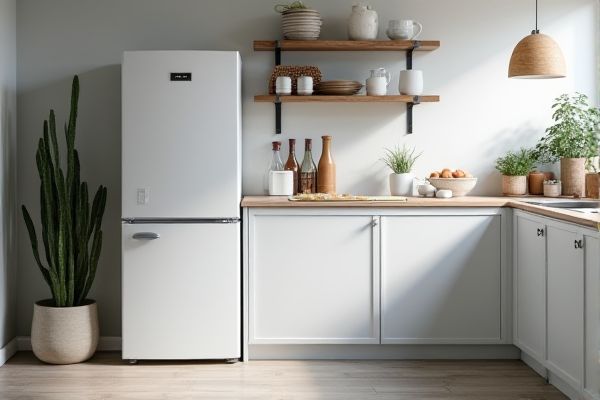
Upright freezers offer easier organization and access with their vertical shelves, making them ideal for limited spaces, while chest freezers provide greater energy efficiency and larger storage capacity, perfect for bulk food storage. Explore this article to determine which freezer best suits your needs and maximizes your food preservation.
Table of Comparison
| Feature | Upright Freezer | Chest Freezer |
|---|---|---|
| Design | Vertical, similar to refrigerator | Horizontal, deep storage box |
| Storage Capacity | Less usable space due to shelves and door compartments | More usable volume, ideal for bulk storage |
| Space Efficiency | Takes up less floor space, taller footprint | Occupies more floor space, lower height |
| Energy Consumption | Generally higher energy use | Typically more energy efficient |
| Access and Organization | Easy access with shelves and compartments | Requires digging through bins, less organized |
| Price | Usually more expensive | Generally more affordable |
| Defrosting | Often has automatic defrost | Usually manual defrost required |
| Ideal Use | Small households, easy access | Large families, long-term bulk storage |
Introduction to Upright and Chest Freezers
Upright freezers offer convenient vertical storage with multiple shelves, making organization and access easier in limited spaces. Chest freezers provide larger storage capacity and better energy efficiency by maintaining cold air when opened, ideal for bulk purchases and long-term food storage. Choosing between the two depends on Your available space, storage needs, and energy preferences.
Design and Space Considerations
Upright freezers offer a vertical design that fits well in narrow spaces and provides easy access to items with multiple shelves and door compartments, optimizing organization and visibility. Chest freezers utilize a horizontal design with a larger storage capacity per square foot, making them ideal for bulkier items and longer-term storage, though they require more floor space and access typically from the top. Selecting between an upright and chest freezer depends largely on available room dimensions, preferred storage style, and the frequency of freezer access.
Storage Capacity Comparison
Upright freezers typically offer easier access with multiple shelves but may have slightly less usable storage space compared to chest freezers, which maximize volume with a deep, open interior ideal for bulk storage. Chest freezers generally provide more cubic feet per footprint, accommodating larger quantities of food and bulky items more efficiently. Choosing between the two depends on whether you prioritize organized accessibility or maximum storage capacity.
Energy Efficiency and Consumption
Upright freezers typically consume more energy than chest freezers due to their vertical design, causing cold air to escape more easily when the door is opened. Chest freezers are generally more energy-efficient because their thick insulation and horizontal layout minimize cold air loss, reducing compressor workload. Energy Star-rated chest freezers often outperform upright models by using up to 15-20% less electricity annually.
Accessibility and Organization
Upright freezers offer easier accessibility with multiple shelves and door bins, allowing you to organize items by category and quickly locate what you need. Chest freezers provide more usable space without shelves, making them ideal for bulk storage but requiring you to dig through layers, which can hamper organization. Your choice depends on whether you prioritize easy access and systematic arrangement or maximizing storage capacity.
Price and Cost Analysis
Upright freezers generally have a higher price point compared to chest freezers due to their space-saving vertical design and ease of access. Chest freezers offer better energy efficiency, often resulting in lower long-term operating costs despite a higher initial purchase price for larger models. Your choice should consider both upfront cost and ongoing electricity expenses to maximize value.
Defrosting and Maintenance
Upright freezers typically feature automatic defrost systems, reducing ice buildup and making maintenance easier compared to chest freezers that generally require manual defrosting. Chest freezers maintain lower temperatures more efficiently due to better insulation, but their manual defrosting process demands more time and effort to prevent ice accumulation. Regular defrosting in chest freezers is crucial to sustain optimal performance and energy efficiency over time.
Longevity and Durability
Upright freezers typically offer easier access and organization but may have shorter longevity due to door seal wear and compressor strain from frequent opening. Chest freezers are known for their durability and longer lifespan, often lasting over 15 years, thanks to fewer moving parts and better insulation that reduces compressor cycles. Choose your freezer based on how often you open it, with chest freezers providing enhanced durability for long-term storage needs.
Best Uses and Ideal Users
Upright freezers are ideal for users who prioritize easy access and organized storage, making them best suited for small kitchens or frequent use. Chest freezers offer more storage capacity and energy efficiency, perfect for large families or bulk buyers who need long-term storage. You should choose based on your space availability and how often you plan to access frozen items.
Final Verdict: Upright vs Chest Freezer
Upright freezers offer easier organization and quicker access with multiple shelves, making them ideal for smaller spaces and frequent use, while chest freezers provide more energy efficiency and larger storage capacity, suited for long-term storage and bulk purchases. Energy Star-rated chest freezers typically consume less electricity, saving on utility bills over time, whereas upright models prioritize convenience and space-saving design. Choosing between upright and chest freezers depends on your specific storage needs, space availability, and energy consumption priorities.
 homyna.com
homyna.com